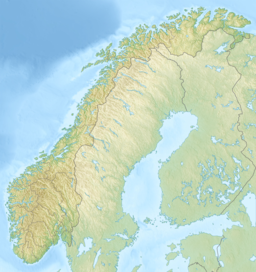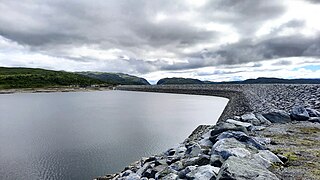| Songavatnet | |
|---|---|
| Songevatnet / Songavatn | |
 View of the lake | |
| Location | Vinje Municipality, Telemark |
| Coordinates | 59°51′05″N 7°30′30″E / 59.8515°N 7.50838°E |
| Primary outflows | Songa river |
| Catchment area | 384 km2 (148 sq mi) |
| Basin countries | Norway |
| Max. length | 14.3 kilometres (8.9 mi) |
| Max. width | 5 kilometres (3.1 mi) |
| Surface area | 29.86 km2 (11.53 sq mi) |
| Max. depth | 21 metres (69 ft) |
| Surface elevation | 974 metres (3,196 ft) |
| References | NVE[1] |
Songavatnet (also spelled as Songevatnet or Songavatn) is a lake in Vinje Municipality in Telemark county, Norway. It has a surface area of 29.86 square kilometres (11.53 sq mi) and lies at an elevation of 974 metres (3,196 ft). The lake lies just south of the border of Hardangervidda National Park and just southeast of the mountain Vassdalseggi. The villages of Haukeli and Edland are both located about 9 kilometres (5.6 mi) to the south of the lake and the village of Arabygdi lies about 10 kilometres (6.2 mi) to the southeast of the lake. The lake flows out into the river Songa which flows to the southeast into the nearby lake Totak.[1][2]
Songavatnet has two dams: Trolldalsdammen and Songadammen. Both are rock-fill dams with a sealing core of moraine mass. The larger dam, Songadammen, measures 1,050 metres (3,440 ft) long and 37 metres (121 ft) high. The two dams on the south end of the lake are used to regulate the surface elevation of the mountain lake so that it can be used for hydroelectric power production. This was the largest dam in Northern Europe at the time it was completed in the 1960s. The stored energy content of the reservoir is 1.4 terawatt-hours (5.0 PJ).[2]
Media gallery
[edit]-
View of the lake
-
Songadammen from the east
-
Songadammen from the south
-
Songadammen from the west
-
View from the Trolldalsdammen
-
Trolldalsdammen from the east
See also
[edit]References
[edit]- ^ a b "Innsjødatabase". nve.no (in Norwegian). Retrieved 7 January 2023.
- ^ a b Rosvold, Knut A., ed. (22 December 2021). "Songavatn". Store norske leksikon (in Norwegian). Kunnskapsforlaget. Retrieved 7 January 2023.








Well, that’s interesting to know that Psilotum nudum are known as whisk ferns. Psilotum nudum is the commoner species of the two. While the P. flaccidum is a rare species and is found in the tropical islands. Both the species are usually epiphytic in habit and grow upon tree ferns. These species may also be terrestrial and grow in humus or in the crevices of the rocks.
View the detailed Guide of Psilotum nudum: Detailed Study Of Psilotum Nudum (Whisk Fern), Classification, Anatomy, Reproduction